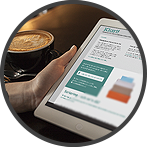What you could write on the sign
Datum: 2023-05-23 08:30

If you are lucky enough to have a door which you can close behind you whenever you need a moment or two to work undisturbed, you will most likely have noticed that a door isn’t always enough to keep interruptions out.
There is a knock on the door and a colleague pops in to ask if you’ve got a moment. If you have a window facing the corridor next to your entrance, the colleague will undoubtedly stand in it, waving to get your attention. And if you lock it and turn you back, they will unlock it and stick their heads in to ask if everything is alright.
For you who prefer listening to reading, this post is also available as an episode of the “Done!” podcast:
Talk about this too
Judging by what I hear from all the participants attending my courses and lectures who I meet every week, it is most essential that we find ways to clearly communicate that we wish to be undisturbed to those who would potentially seek our attention (colleagues, most likely).
One easy way to communicate our desire to sometimes be left undisturbed is to bring it up during the next group‑, team‑, department‑, office‑, or staff meeting and discuss how you will make it clear to the others when you are available for questions and interruptions, and when you are not.
Or, signify it with a sign
Perhaps you do not feel entirely comfortable bringing it up during a meeting, for whatever reason. If so, the most clear way you can communicate when you are available and when you are not, is by putting up a sign or note on your door. One classic way of phrasing your sign is ”Do not disturb”, but perhaps your colleagues do not perceive their popping their heads through your door as disturbing you. They just wanted to say hello. Some think that having a sign at all is slightly too impersonal and if it reads ”Do not disturb”, some find it down right rude.
But, a sign in itself is just a sign, and you can phrase it in a number of ways. And most importantly, we can choose to write something that is both friendly and clear. But what? Here are a few examples of what others have written:
- A woman I met felt that ”Do not disturb” was too harsh, so she chose to write: ”Dear colleague; I am delighted that you want to speak with me. However, I need to work on a particularly important task undisturbed right now, but I will be available again at 11 o’clock, so please come back then instead.”
- Someone else wrote: ”Need to concentrate on something right now. Send me an email — I check my inbox every hour.”
- When I was in the south of Sweden the other week, a participant in one of my courses told me that her sign says: ”Pretend as if I am not here.” Brilliantly simple, if you ask me.
- A man told me that he puts up a sign depicting a dragon that signalled to his colleagues (after having initially explained its meaning to them) that he was unavailable at the moment — when the sign with the dragon was on the door, they knew to stay clear of his office.
The people in the examples have one thing in common — they all strive to unambiguously convey something to anyone who wants to disturb them. One person signals when they are available, another suggest an alternative to knocking on the door (emailing them instead), a third person helps their colleagues know how to react to their closed door, and the final person uses an image that communicates a clear message to his potential visitors.
Do this
If your signs tend to be ineffective but you still do not want to bring the matter of not being disturbed up during a meeting, then try this:
- Take a moment to think about what you could write on your sign the next time you need to work uninterrupted with something, and that first of all let your colleagues to know what to do with the question or matter they wanted your opinion on, and secondly makes it clear to them that you wish to be left alone. The text you choose to write could for instance answer the following questions:
- What types of questions are you still available for, in spite of wanting to be left undisturbed?
- When will you be available again?
- In what format or how do you wish to receive the question or the information, rather than face to face?
- What are you going to work with while remaining undisturbed? Knowing this will make it easier for people to leave you alone at these times.
- How could they help you (if they want to) so that you finish faster (and hence become available earlier)?
- Create a first digital version of the sign in your favorite editor or software so that you have a template to use the next time you want to be left alone. Making a first sketch will also make it easier to continuously refine and improve the sign so that you eventually will have formulated the perfect message in an excellent format that will help both you and your colleagues to get things done.
Sometimes a closed door is not really closed
If you hang a pleasantly phrased but clear sign on your door, your colleagues will adhere to your request of not being disturbed more often. The person who seeks your attention will be met with a clear indication of that now isn’t the best moment, but also an indication of when you will be available again.
You will be left alone to concentrate on your important task and what you produce will be of higher quality than it usually is after having been interrupted time and again throughout trying to finish, which in turn reduces the risk of having to spend time making corrections later on.
What does your sign say?
What have you written on your sign? I would love to have more examples, so please tell me.
(Anna, who attended one of my lectures, has a rather radical — and fun — way of signaling that she needs to focus.)

If you want more tips on how to create good structure at work, there are many ways to get that from me - in podcasts, videos, books, talks and other formats.




